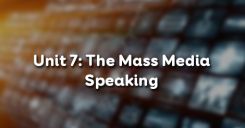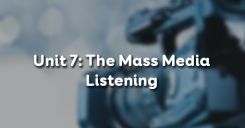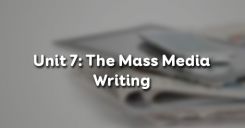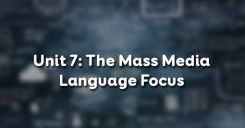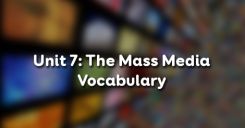B├Āi hß╗Źc Reading Unit 7 tiß║┐ng Anh lß╗øp 10 - The Mass Media hŲ░ß╗øng dß║½n c├Īc em ─æß╗Źc b├Āi t├¼m hiß╗āu vß╗ü c├Īc k├¬nh phŲ░ŲĪng tiß╗ćn truyß╗ün th├┤ng hiß╗ćn ─æß║Īi. Qua ─æ├│ gi├║p c├Īc em ─æß╗ŗnh ngh─®a mß╗Öt sß╗æ kh├Īi niß╗ćm vß╗ü mß╗Öt sß╗æ k├¬nh truyß╗ün h├¼nh.
T├│m tß║»t b├Āi
1. Before You Read Unit 7 Lß╗øp 10
Work with a partner. Ask and answer the following questions. (L├Ām viß╗ćc vß╗øi bß║Īn hß╗Źc. Hß╗Åi v├Ā trß║Ż lß╗Øi c├Īc c├óu hß╗Åi sau.)
1. When do you often watch TV? (Bß║Īn thŲ░ß╗Øng xem tivi v├Āo khi n├Āo?)
2. How many channels are there on our national TV? (─É├Āi truyß╗ün h├¼nh quß╗æc gia cß╗¦a ch├║ng ta c├│ bao nhi├¬u k├¬nh?)
3. How many hours per week do you watch TV? (Bß║Īn xem tivi bao nhi├¬u giß╗Ø mß╗Śi tuß║¦n?)
Guide to answer
1. I often watch TV after dinner.
2. Besides the channels of national TV Stations and HCM City TV channels, nearly every province has its own television station.
3. I usually watch TV about nine hours per week.
2. While You Read Unit 7 Lß╗øp 10
Look at some popular programmes, and then do the tasks that follow. (Nh├¼n v├Āo c├Īc chŲ░ŲĪng tr├¼nh phß╗Ģ biß║┐n, v├Ā sau ─æ├│ l├Ām c├Īc b├Āi tß║Łp theo sau.)
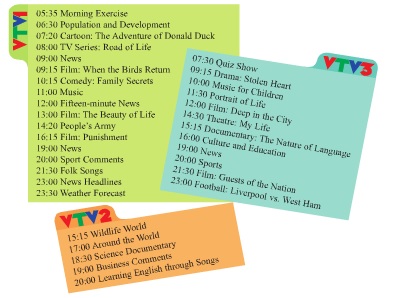
2.1. Unit 7 Lß╗øp 10 Reading Task 1
The words in A appear in the reading passage. Match them with their definitions in B. (Nhß╗»ng tß╗½ ß╗¤ A xuß║źt hiß╗ćn trong b├Āi ─æß╗Źc. Gh├®p ch├║ng vß╗øi ─æß╗ŗnh ngh─®a ß╗¤ B.)
| A | B |
|
1. cartoon 2. drama 3. comedy 4. documentary |
a. a play for the theatre, television or radio b. a film or a television programme giving facts about something c. a film made by photographing a series of changing drawings d. a film or a play that is intended to be funny, usually with a happy ending |
Guide to answer
1 - c
2 - a
3 - d
4 - b
cartoon: phim hoß║Īt h├¼nh
comedy: phim h├Āi kß╗ŗch
drama: kß╗ŗch, tuß╗ōng
documentary: phim t├Āi liß╗ću
2.2. Unit 7 Lß╗øp 10 Reading Task 2
Decide whether the following statements are true (T) or false (F). Correct the false information. (X├Īc ─æß╗ŗnh xem nhß╗»ng ph├Īt biß╗āu sau l├Ā ─æ├║ng(T) hay sai (F). Sß╗Ła th├┤ng tin sai.)
1. There are five news programmes on the three channels.
2. There is a comedy programme on between 10:15 and 11:00
3. The Nature of Language is a documentary programme at 15:15 on VTV2.
4. The film Punishment is shown at 4:15 p.m on VTV1
5. VTV starts at 5:35 and ends at 23:30.
Guide to answer
1. T
2. T
3. F
=> The nature of language is the documentary programme at 15:15 on VTV3.
4. T
5. F
=> VTV1 starts at 5:35 and the last programme starts at 23:30.
2.3. Unit 7 Lß╗øp 10 Reading Task 3
Work in pairs. Ask and answer the following questions. (L├Ām viß╗ćc theo cß║Ęp. Hß╗Åi v├Ā trß║Ż lß╗Øi c├Īc c├óu hß╗Åi sau.)
1. How many films are on? (C├│ bao nhi├¬u phim ─æŲ░ß╗Żc chiß║┐u?)
2. What time can you watch the news? (Bß║Īn c├│ thß╗ā xem tin tß╗®c v├Āo thß╗Øi gian n├Āo?)
3. Which chanel do you recommend to someone who like annimals? (Bß║Īn sß║Į gß╗Żi ├Į k├¬nh n├Āo cho ai ─æ├│ y├¬u ─æß╗Öng vß║Łt?)
4. What programme is on on VTV3 at 7:30? (ChŲ░ŲĪng tr├¼nh n├Āo c├│ tr├¬n VTV3 v├Āo l├║c 7 giß╗Ø 30?)
5. Which channel will you watch if you like folk songs? (Bß║Īn sß║Į xem k├¬nh n├Āo nß║┐u bß║Īn th├Łch d├ón ca?)
6. What is the last programme on VTV3? (ChŲ░ŲĪng tr├¼nh cuß╗æi c├╣ng tr├¬n VTV3 l├Ā chŲ░ŲĪng tr├¼nh g├¼?)
Guide to answer
1. Five films are on.
2. I can watch the news at 9:00, 12:00 noon; 19:00 and 23:00 on VTV1 and at 19:00 on VTV3.
3. VTV2
4. The programme on VTV3 at 7:30 is the "Quiz Show".
5. You should watch VTV1 at 21:30.
6. The last programme on VTV3 is the "Football".
3. After You Read Unit 7 Lß╗øp 10
Work in pairs. Tell your partner about one of the TV programmes you like watching best and explain why. (L├Ām viß╗ćc theo cß║Ęp. H├Ży kß╗ā cho bß║Īn hß╗Źc vß╗øi em vß╗ü mß╗Öt trong nhß╗»ng chŲ░ŲĪng tr├¼nh truyß╗ün h├¼nh em th├Łch xem nhß║źt v├Ā giß║Żi th├Łch tß║Īi sao.)
Guide to answer
I like watching the programmes such as the "Wildlife World" and "Culture and Education" best, because these programmes provide me with the knowledge of the life of wild animals and of the matters of various cultures and of education in our country and around the world. Thanks to these. I can broaden the horizon of my knowledge.
4. B├Āi dß╗ŗch Reading Unit 7 Lß╗øp 10
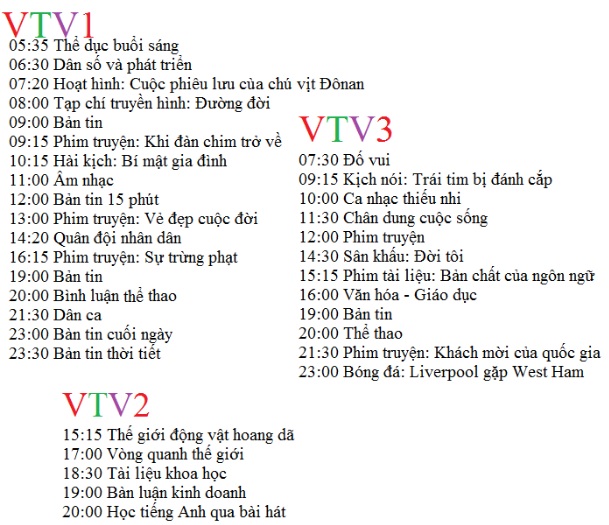
B├Āi tß║Łp minh hß╗Źa
Read the following passage carefully, and then select the best option A, B, C or D to complete it:
WORLD WIDE WEB
World Wide Web (WWW), computer-based (1) _______ of information resources that combines text and multimedia. The information on the World Wide Web can be accessed and searched through the (2) _______, a global computer network. The World Wide Web is often (3) _______ to simply as ŌĆ£the Web.ŌĆØ
The Web started to become a (4) _______ resource after 1993 when the first widely distributed browser provided a convenient way to (5) _______ a variety of information on the Internet. The Web uses (6) _______, which means that information can be displayed in a wide variety of formats. (7) _______ can read text, view pictures, watch animation, listen to sounds, and even explore interactive virtual environments on the Web. A user can (8) _______ seamlessly from a document or Web page stored on the computer to a document or Web page (9) _______ on another computer.
The Web offers a place where companies, universities and (10) _______ institutions, and individuals can display information about their products, services, facilities, or research, or their (11) _______ lives. Only a small percentage of information on the (12) _______ is restricted to subscribers or other authorized users. The majority of Web pages are available to (13) _______ who can access a computer that connects to the Internet. The Web has become a (14) _______ for many companies selling products or services, and a forum for people to exchange opinions and information. Museums, libraries, government agencies, and schools post information on the Web to make it (15) _______ to others.
New vocabulary:
- seamless (adj.): kh├┤ng c├│ ─æŲ░ß╗Øng nß╗æi, liß╗ün mß╗Öt m├Żnh
- institution (n.): cŲĪ quan, trß╗ź sß╗¤ cŲĪ quan
- restrict (v.): hß║Īn chß║┐, giß╗øi hß║Īn, thu hß║╣p
- subscriber (n.): ngŲ░ß╗Øi ─æß║Ęt mua, ngŲ░ß╗Øi ─æ─āng nhß║Łp
1/ A. system B. source C. network D. resource
2/ A. Computer B. Radio C. Television D. Internet
3/ A. said B. referred C. told D. considered
4/ A. popular B. normal C. ordinary D. favorite
5/ A. enter B. access C. come into D. arrive at
6/ A. yahoo B. Media Player C. information D. multimedia
7/ A. Users B. People C. Customers D. Shop keepers
8/ A. go B. move C. fly D. run
9/ A. placed B. put C. installed D. stored
10/ A. another B. others C. other D. one another
11/ A. private B. popular C. common D. possessive
12/ A. Computer B. Network C. System D. Web
13/ A. no one B. everyone C. someone D. anyone
14/ A. school B. hospital C. marketplace D. company
15/ A. good B. available C. free D. valuable
Key
1/ C. network ; 2/ D. Internet ; 3/ B. referred ; 4/ A. popular
5/ B. access ; 6/ D. multimedia ; 7/ A. Users ; 8/ B. move
9/ D. stored ; 10/ C. other ; 11/ A. private ; 12/ D. Web
13/ D. anyone ; 14/ C. marketplace ; 15/ B. available
B├Āi tß║Łp trß║»c nghiß╗ćm Reading Unit 7 Lß╗øp 10
NhŲ░ vß║Ły c├Īc em vß╗½a xem qua b├Āi hß╗Źc Reading Unit 7 tiß║┐ng Anh lß╗øp 10 v├Ā thß╗▒c h├Ānh l├Ām b├Āi tß║Łp minh hß╗Źa. ─Éß╗ā cß╗¦ng cß╗æ v├Ā r├©n luyß╗ćn kß╗╣ n─āng ─æß╗Źc hiß╗āu mß╗Øi c├Īc em tham gia thß╗▒c h├Ānh Trß║»c nghiß╗ćm Unit 7 lß╗øp 10 Reading
-
Câu 1:
Read the passage below carefully, and then select the correct option A, B, C or D
The World Wide Web was developed by British physicist and computer scientist Timothy Berners-Lee as a project within the European Organization for Nuclear Research (CERN) in Geneva, Switzerland. Berners-Lee combined several existing ideas into a single system to make it easier for physicists to use data on the Internet. Most important, he added multimediaŌĆöthe ability to include graphicsŌĆöto the hyperlink concept found in a previous Internet service known as gopher. Berners-Lee had begun working with hypertext in the early 1980s. An early prototype implementation of the Web became operational at CERN in 1989, and the idea quickly spread to universities in the rest of the world.
Groups at the National Center for Supercomputing Applications at the University of Illinois at Urbana-Champaign researched and extended Web technology. They developed the first browser that was used at many sites, named Mosaic, in 1993. To allow the Web to be accessed from a wide variety of computer systems, researchers built multiple versions of Mosaic. Each version was designed to be used with a specific operating system, the software that controls the computer. Within a year, computer programmer Marc Andreessen had formed a commercial company, Netscape Communications Corporation, to build and sell Web technologies.
The World Wide Web was developed by .........
- A. an American
- B. a British
- C. a Canadian
- D. a French
-
- A. math and physics
- B. math and computer
- C. computer and physics
- D. math, physics and computer
-
- A. Timothy Berners-Lee spoke English very well.
- B. Timothy Berners-Lee was born in Geneva, Switzerland.
- C. Timothy Berners-Lee was the first person to develop WWW.
- D. Some existing ideas were combined into a single system by him.
C├óu 4-10: Mß╗Øi c├Īc em ─æ─āng nhß║Łp xem tiß║┐p nß╗Öi dung v├Ā thi thß╗Ł Online ─æß╗ā cß╗¦ng cß╗æ kiß║┐n thß╗®c vß╗ü b├Āi hß╗Źc n├Āy nh├®!
Hß╗Åi ─æ├Īp Reading Unit 7 Lß╗øp 10
Trong qu├Ī tr├¼nh hß╗Źc b├Āi v├Ā thß╗▒c h├Ānh trß║»c nghiß╗ćm c├│ ─æiß╗ām n├Āo chŲ░a hiß╗āu c├Īc em c├│ thß╗ā ─æß║Ęt c├óu hß╗Åi trong mß╗źc Hß╗Åi ─æ├Īp ─æß╗ā ─æŲ░ß╗Żc sß╗▒ hß╗Ś trß╗Ż tß╗½ cß╗Öng ─æß╗ōng Hß╗īC247. Ch├║c c├Īc em hß╗Źc tß╗æt!
-- Mod Tiß║┐ng Anh 10 Hß╗īC247






